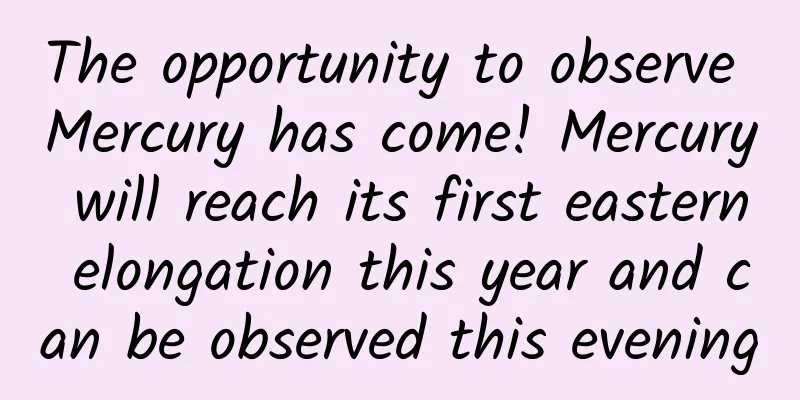The opportunity to observe Mercury has come! Mercury will reach its first eastern elongation this year and can be observed this evening

|
Tianjin, March 6 (Xinhua) -- A good opportunity to observe Mercury in the evening has arrived this year. According to astronomical science experts, Mercury will reach its first eastern elongation this year on March 8. As long as the weather is fine, interested members of the public can observe Mercury with the naked eye or with the help of a small astronomical telescope. The planets in the solar system are divided into two categories: one is the inner planets, which orbit the sun within the Earth's orbit, including Mercury and Venus; the other is the outer planets, which orbit the sun outside the Earth's orbit, such as Mars, Jupiter, Saturn, etc. As the planet closest to the Sun, Mercury always appears near the Sun as seen from Earth, and is hidden in the Sun's light for most of the year. Only when the angle between Mercury and the Sun is at its greatest distance, that is, when Mercury is at its greatest distance, can we barely observe Mercury. Mercury will reach its greatest western elongation on December 25, 2024. This is Mercury (upper left) and the moon photographed in Haidian District, Beijing on December 29 of the same year. (Photo by Wang Junfeng) If Mercury is to the east of the Sun, the largest angle between it and the Sun is the eastern elongation; if Mercury is to the west of the Sun, the largest angle between it and the Sun is the western elongation. When the eastern elongation occurs, Mercury will appear low in the west at dusk; when the western elongation occurs, Mercury will appear low in the east at dawn. Yang Jing, a member of the Chinese Astronomical Society and director of the Tianjin Astronomical Society, said that Mercury moves very fast and only takes about 88 days to orbit the sun. Therefore, the eastern and western elongations occur 3 to 4 times a year. This year, Mercury will have three eastern elongations and three western elongations. The altitude of Mercury during these six elongations is different, and the observation conditions are also different, some good and some bad. Mercury will reach its greatest eastern elongation on January 7, 2022. This is Mercury and the moon photographed in Dongli District, Tianjin on January 4 of the same year. (Photo by Yang Jing) The three times this year when Mercury reaches its greatest eastern elongations are March 8, July 4, and October 30. "Both March and July are suitable for observation, but the March one is even better. During this greatest elongation, Mercury's altitude above the horizon at sunset reached 17 degrees, and the observation conditions were very ideal," Yang Jing said. How to find Mercury? "If the weather is fine, after sunset a few days before and after the 8th, interested members of the public can try to look for it low in the western sky with the naked eye or with the help of binoculars or a small astronomical telescope. Mercury will set about an hour after sunset, so the best time to find Mercury is during this period. Of course, using the bright Venus as a reference, Mercury can be found relatively easily. During this period of greatest eastern elongation, Mercury will be not far below Venus." Yang Jing said. Mercury will be at its greatest eastern elongation on December 21, 2022. This is Mercury and Venus photographed in Nankai District, Tianjin on December 27 of the same year. (Photo by Yang Jing) It is worth mentioning that on March 9, Mercury will be in conjunction with Mars, and in the following days the two will be even closer, presenting a "star attraction". This is a good opportunity to observe and photograph the two planets at the same time. If you shoot for several consecutive days, you can also record the position changes between the two. The public who are interested should not miss it. |
Recommend
A Beginner's Guide to Motion Effects for UI Designers
UI Designer's Motion Effects Beginner's Gu...
Do these 4 things regularly to make you look older than your peers! Huaxi doctors: You can effectively fight aging without spending money
Next Saturday is New Year’s Eve! During the Chine...
Can “sad” music make people happy? I’m confused…
Scientists are intrigued by the fact that we can ...
Community monetization: the unbearable pain of community operators
1. Why do we need to talk about monetization? Wha...
Why do the things we longed to grab on Double Eleven not seem so attractive after we get them?
Review expert: Li Xianhong, National Level 2 Psyc...
B Station Brand Marketing Guide!
Keywords of this article: Bilibili , brand market...
Foreign media: Size and function are important for iPhone to sell well
Foreign media analysis said that the market deman...
Why the horse-faced skirt has become the new top trend in the fashion circle? Thousands of years of evolution history will tell you
Contemporary Society Wearing a horse-faced skirt ...
3 steps to quickly activate private domain inventory!
It has been several years since the private domai...
The starshade is like a petal, the main mirror is like a honeycomb... See the unique designs of astronomical telescopes
On March 16, according to media reports, China pl...
Xiaomi opens a flagship store on JD.com: no longer selling futures but spot goods?
On May 28, Xiaomi and JD.com jointly announced th...
Analysis of short video operation methods
Accounts related to agriculture, rural areas and ...
This parasite can kill people, but it's a ray of hope for cancer patients
Injecting live parasites into the human body can ...
Practical traffic diversion skills for Douyin (Part 1)
In order to help you learn the course better, tod...
It turns out that the more cameras a phone has, the better it is. The secondary camera is mostly auxiliary, and the main camera is the focus
Nowadays, smartphones often have several cameras....









